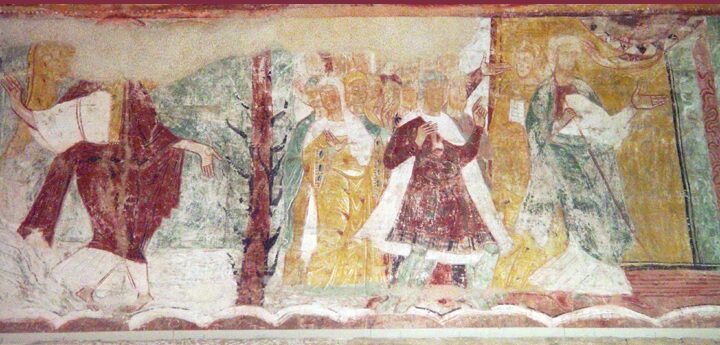Commentary on Romans 6:3-11
Death Baptism and Mutual Entombment
The idea of being “plunged into someone’s death” and being “entombed” with them, as in Romans 6:3–4, is unnerving. In most contexts, this language would strike us as peculiar and eerie. Yet, within the Christian tradition, these images have been so thoroughly assimilated that they have lost their spookiness. After all, many of us wear a symbol of death—namely, the cross—as jewelry on our person.
The word that usually is translated “buried with” (synetaphēmen) in Romans 6:4 literally means to be buried together, as in a shared grave. The image finds an unexpected parallel in the Roman author Aelian, who wrote some 150 years after Paul. In his treatise On the Characteristics of Animals, Aelian (rightly) extols dogs for their loyalty. As one of several illustrations, he tells the story of a lap dog who jumped into its dead owner’s coffin and so was “buried with” him. The account is meant to be humorous, if not also a touch gruesome.
Gruesome death language permeates Romans 6:3–11. There is a distinct contrast in the passage between life and death. While the celebration of Easter predominantly highlights the former, it is crucial to recognize that the exaltation of new life is intertwined with death. Celebration of new life comes only through death. Easter Sunday follows Maundy Thursday, Good Friday, and Holy Saturday.
In these verses, death language is paired with life language. Yet, in sheer numerical terms, references to death outweigh those to life. Thirteen times Paul mentions death, while life occurs six times.
Death:
- “We were baptized into his death” (verse 3)
- “We were buried with him” (verse 4)
- “By baptism into his death” (verse 4)
- “From the dead” (verse 4)
- “In the likeness of his death” (verse 5)
- “Our old person was co-crucified” (verse 6)
- “The one dying” (verse 7)
- “We died with Christ” (verse 8)
- “Christ was raised from the dead” (verse 9)
- “He died to sin” (verse 10)
- “We reckon ourselves dead bodies” (verse 11)
Negation of death:
- “He no longer dies” (verse 9)
- “Death no longer rules” (verse 9)
Life and resurrection:
- “He was raised” (verse 4)
- “We should walk in newness of life” (verse 4)
- “We will be united also in his resurrection” (verse 5)
- “We will live with him” (verse 8)
- “He lives to God” (verse 10)
- “We reckon ourselves living” (verse 11)
Death is past, life is present
The contrast in Romans 6 continues Paul’s juxtaposition from Romans 5:12–21 of two different domains that are associated with two different individuals. On the one hand, there is the realm of sin and death associated with the first human and his trespass. On the other hand, there is the new realm of grace, righteousness, and life associated with Jesus and his obedience.
Romans 5 culminates with a comparison between the dominion of sin in the past and the potential reign of grace in the present and future. Sin ruled in the past, whereas grace might rule in the present and future. This grammatical dichotomy is emphasized through the use of the aorist indicative mood, denoting actions completed in the past, and the subjunctive mood, suggesting potential or probable future actions. In Romans 6:1–11, Paul extends this contrast, providing an exposition of its results for believers. Romans 5 presents the two different realms. Romans 6 elaborates how believers have moved from the old to the new.
The contrast continues with the rhetorical question in Romans 6:2: “How can we who died to sin go on living in it?” (New Revised Standard Version) The English translation melds what is set in opposition in Greek. There are two distinct clauses that might be literally translated, “We who died to sin, how can we continue living in it?” The word signaling that the sentence is a question, pōs, does not appear until the second clause.
The implication is that the first clause is a statement of fact, while the second is a rhetorical question that builds upon it. Like the rhetorical question in Romans 6:1—“Should we continue in sin in order that grace may abound?”—the question in Romans 6:2 ought to be answered emphatically in the negative.
Question: How can we continue living in sin?
Implied answer: We can’t!
Variation between the past and future tenses continues throughout Romans 6:3–11 to emphasize Paul’s contrast. Death is always associated with the past: we were baptized into death (verse 3), we were buried (verse 4), our old person was co-crucified (verse 6), we died with Christ (verse 8). In contrast, new life is always associated with present and future possibility: we should walk in newness of life (verse 4), we will be united (verse 5), we will live with him (verse 8), death no longer rules (verse 9).
Sin and death are associated with the past, old realm. In baptism, Christ-believers have died to this realm and been made alive to the new one. Baptism was and is an initiation rite that signals one’s entry into a new realm. Whatever denominational practice of baptism one utilizes today, the verb “baptize” in its ancient context was used with respect to complete immersion of something into something else. Thus, it can also be translated “plunge,” “soak,” or “wash.” Again, the imagery is gruesome: we were plunged into Jesus’ death and stuck into his grave.
But Jesus did not stay in his grave, and neither do we. Jesus’ death put the dominion of death to death. For Paul, death and resurrection are effective. The gruesomeness of Good Friday and Holy Saturday is transformed into the glory of new life on Easter Sunday. As Paul states in Romans 6:11, we are now “dead to sin and alive to God in Christ Jesus.”


March 30, 2024